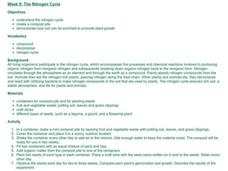Curated OER
The Alternative Fix: What Is Complementary and Alternative Medicine?
High schoolers study the use of alternative and complementary medicines. They research the five categories of CAM therapies and how popular they are. They report their finding to the rest of the class.
Curated OER
The Heart of the Matter
Students study the heart and the circulatory system. They practice taking their pulse. They create a model of blood cells and squeeze tennis balls to demonstrate just how hard the heart muscle works.
Curated OER
Simple Machines IV - Wheels and Axles
Fourth graders study everyday examples of simple machines. They examine how the combination of a wheel and axle works more efficiently than either in isolation. In a demonstration instructional activity, they see how a spring scale shows...
Curated OER
The Grand Canyon
Fourth graders study the Grand Canyon. They research the Grand Canyon and locate the Colorado River on the map of Arizona. They discuss erosion and read how sedimentary rock was formed. They view photographs of the Grand Canyon and...
Curated OER
Classification of an Echinoderm
Students study starfish through dissection. In this biology lesson plan, students explore the lives of starfish as they view a slide show, observe parts of echinoderms, and compare the classification of the starfish with other...
Curated OER
The Hall of Physicist
Students study the history and scientific contributions of Albert Einstein. In this Albert Einstein lesson plan, students learn his history, research his scientific contributions, create a timeline of him and his work, and create a...
Curated OER
The Water Cycle and Global Warming
Students study the flow of water in the environment. In this water cycle lesson students evaluate the consequences of changes in the water cycle using data.
Curated OER
Neuron Creations
Students examine neurons. In this nervous system lesson, students build models of neurons in order to study their parts and functions.
Curated OER
Rocks and Minerals
Students identify how weathering and erosion effect the Earth's surface. In this weathering and rocks lesson, students study various types of rocks in water and brainstorm ways the Earth's surface changes. Students view an interactive...
Curated OER
The Technology of Light
Learners study the different types of light bulbs. In this exploratory instructional activity students complete several activities and create an electrical circuit.
Curated OER
Introduction to Constellations
Students examine constellations. In this astronomy lesson, students study various constellations and identify five major constellations. They will construct a model of one of the constellations.
Curated OER
Off Base
Students study La Chatelier's principle and identify how carbon dioxide may affect pH. In this coral lesson students complete a worksheet on pH and observe a lab.
Curated OER
Acid Rain And Geology
Learners become aware of the environmental problems caused by acid rain and study the pH scale. They determine acidity of local rain water.
Curated OER
Hot Gas Or Cold Gas Lab
Students engage in a lab project to study chemical reactions. They use guided questions to help facilitate the lab experience and come to the correct outcomes. The lesson does not contain a true understandable objective. The lesson could...
Curated OER
Celebrating 100 Years of Flight for Grades 3-5
Students study the history of flight of the past one hundred years, focusing on the invention of the airplane, the introduction of women pilots and the space race. They conduct research and then write and publish a "100 Years of Flight"...
Curated OER
Polymers, Where Are You?
Students study polymers and what they are used for. In this investigative lesson students view a video on ploymers, and research on the Internet specific polymers and processes.
Curated OER
The Puzzle of the Ice Age Americans
Learners describe alternative theories for how the first humans cane to America. In this human origin instructional activity students study the origins of the first Americans.
Curated OER
Immunization
students study contents and origin of vaccines. They should understand the relationship of the vaccine to primary and secondary immune responses of the body. They work in pairs and share the responsibility of writing responses to...
Curated OER
Observing Fall Migrants
Pupils observe the migration of monarch butterflies. They collect data regarding the number of monarchs they see, the location, the butterflies' behavior, the temperature and the date and time. Then they send their data to a university...
Curated OER
The Nitrogen Cycle
Students design and create a compost pile in order to study the Nitrogen Cycle. They then use the scientific method to determine if plants grow better when they add organic matter from their compost pile to the plant's soil.
Curated OER
Plant Life of the Rainforest
Students study pictures of tropical rainforests and discuss its stratified character. Students then work with a partner to make a scale drawing of the rainforest strata.
Curated OER
How do pollutants bioaccumulate and biomagnify?
Learners review the basic concepts of the food chain. In small groups, they research an organism and create a food web. In addition, they study biomagnifications and write a brief essay or make a poster informing others about the...
Curated OER
Physical Changes and States of Matter
Fourth graders study evaporation and condensation as parts of the water cycle. First they determine the similarities and differences between a cup of water and an ice cube before measuring the volume of ice before melting it, and...
Curated OER
Send in the Clouds
Learners culminate a study of the water cycle by following step-by-step directions to make a three dimensional cloud. On the model, they draw a diagram of the water cycle and label it, and add a written report they completed in a...























